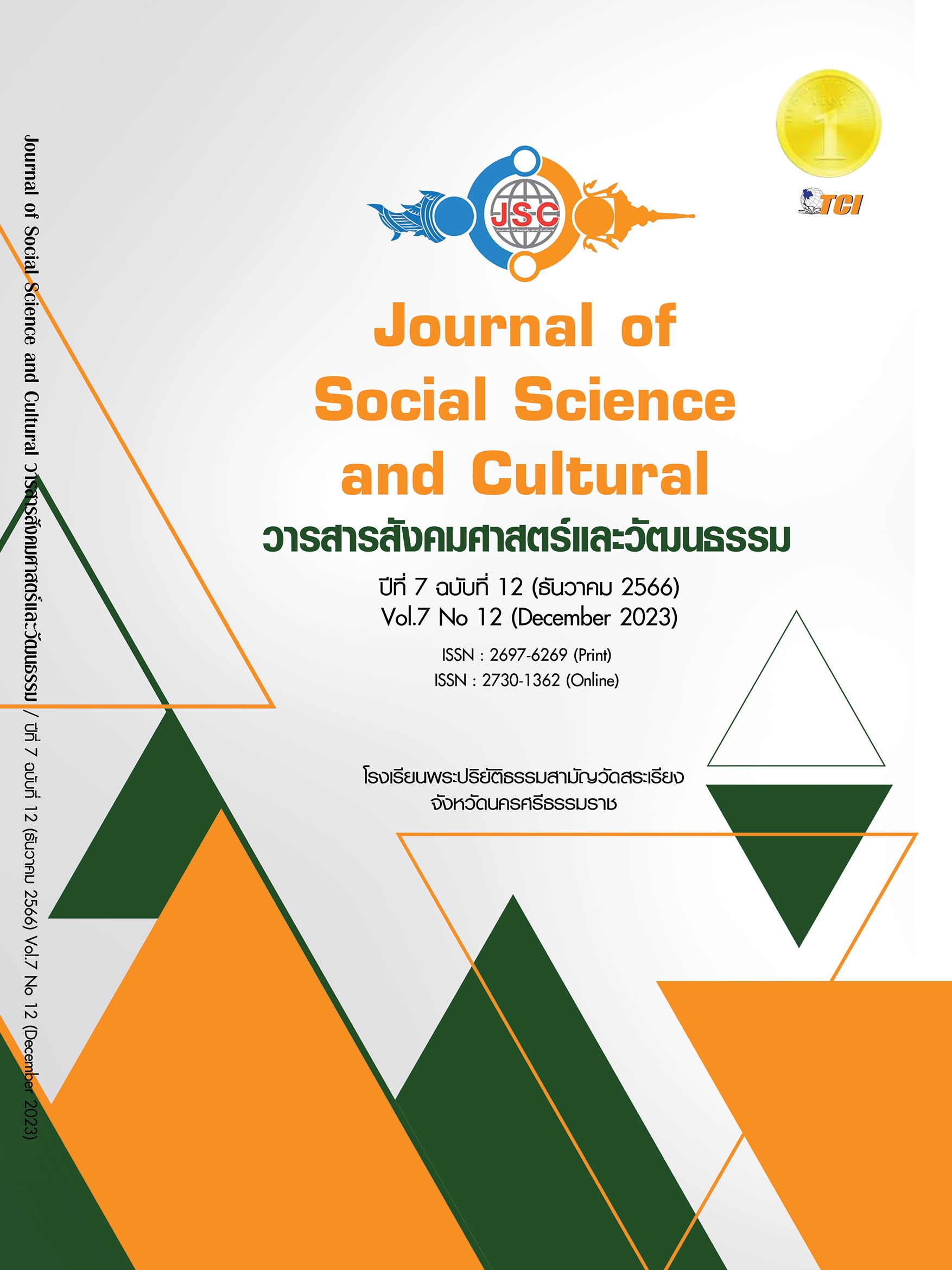DEVELOPING A HEALTH COMMUNICATION MODEL TO ENHANCE THE ELDERLY’S QUALITY OF LIFE
Main Article Content
Abstract
This research aimed to analyze elements contributed to the elderly’s quality of life in Nakhon Si Thammarat. It was also designed to develop a health communication model to enhance the elderly’s quality of life in Nakhon Si Thammarat and to evaluate the developed model was used. There were 224 participants in this study who were home bound: Homecare seniors. Participants were purposively selected by adopting Barthel ADL Index. Participants’ demographic was in Phrom Khiri District, Thasala, and Muang in Nakhon Si Thammarat. Research instruments consisted of the elderly’s quality of life evaluation form, questionnaires on health and information perception, and a health communication model satisfaction form. The descriptive statistics employed for data analysis were mean, median, percentage, average and Standard of Deviation. The results showed that the overview of the elements contributed to the quality of life of the elderly was moderate. Personal interaction ranked the highest, followed by positive emotion, positive health condition, and favorable environment respectively. Frequencies for channels of information and health communication available to the elderly marked the highest from friends, relatives and family members, and followed by television, other sources such as Subdistrict Administrative Organization (SAO) or a Village Head Man accordingly. From the elderly participants’ perspectives, the satisfaction on the information received from the caregivers was at a high level, and a health perception was at a moderate level. In addition, the health communication model developed in this study included different channels health communication, campaigns, social media, and stakeholders such as community health service units, community social welfare etc. The Health Communication Model to Enhance the Elderly’s Quality of Life had been evaluated by five experts before implementing the model with the sample group. It was also found that the satisfaction level on the model was high, and it was suggested that this newly developed health communication model could be transferred to new groups of the elderly caregivers.
Article Details
References
กุลวดี โรจน์ไพศาลกิจ และวรากร เกรียงไกรศักดา. (2560). การพัฒนาแนวทางการดำเนินงานของชุมชนในการพัฒนาสุขภาวะผู้สูงอายุ. วารสารสมาคมนักวิจัย, 22(1), 81-97.
ชัยพัฒน์ พุฒิซ้อน และกันตพัฒน์ พรศิริวัชรสิน. (2561). แนวทางการแก้ไขปัญหาสังคมผู้สูงอายุของประเทศไทย. วารสารเครือข่ายส่งเสริมการวิจัยทางมนุษยศาสตร์และสังคมศาสตร์, 1(1), 25-36.
พระครูภัทรปัญญาคุณ (เวียง แซ่อุ้ย). (2560). การศึกษาความต้องการได้รับสวัสดิการสังคมของผู้สูงอายุในเขตเทศบาลตำบลหัวไทร อำเภอหัวไทร จังหวัดนครศรีธรรมราช. ใน วิทยานิพนธ์พุทธศาสตรมหาบัณฑิต สาขาวิชาการพัฒนาสังคม. มหาวิทยาลัยมหาจุฬาลงกรณราชวิทยาลัย.
ภัทรธิรา ผลงาม. (2561). การส่งเสริมคุณภาพชีวิตผู้สูงอายุในจังหวัดเลย. วารสารประชากรศาสตร์, 34(2), 56-75.
มูลนิธิสถาบันวิจัยและพัฒนาผู้สูงอายุไทย. (2562). สถานการณ์ผู้สูงอายุไทย พ.ศ. 2561. นครปฐม: บริษัท พริ้นเทอรี่ จำกัด.
มูลนิธิสถาบันวิจัยและพัฒนาผู้สูงอายุไทย. (2565). สถานการณ์ผู้สูงอายุไทย พ.ศ. 2564. นครปฐม: สถาบันวิจัยประชากรและสังคม มหาวิทยาลัยมหิดล.
วิสุทธิ์ รอดคำ. (2560). สถานะสุขภาพของผู้สูงอายุในตำบลโรงช้าง อำเภอพรหมบุรี จังหวัดสิงห์บุรี. วารสารสุขศึกษาและสื่อสารสุขภาพ, 3(1), 6-17.
สำนักงานสถิติแห่งชาติ. (2565). บทสรุปสำหรับผู้บริหาร การสำรวจประชากรสูงอายุในประเทศไทย พ.ศ. 2564. กรุงเทพมหานคร: สำนักงานสถิติแห่งชาติ.
สุทธิพงศ์ บุญผดุง. (2554). การพัฒนาคุณภาพชีวิตผู้สูงอายุในท้องถิ่นโดยใช้โรงเรียนเป็นฐานตามหลักเศรษฐกิจพอเพียง (ระยะที่ 1). ใน รายงานการวิจัยทุนอุดหนุนการวิจัย. มหาวิทยาลัยราชภัฏสวนสุนันทา.
สุพรรณี ใจดี และริพันธุ์ สาสัตย์. (2560). การศึกษาภาวะเปราะบางของผู้สูงอายุในชุมชน กรุงเทพมหานคร. วารสารแพทย์นาวี, 44(3), 117-135.
เหมือนฝัน ไม่สูญผล. (2557). กระบวนการสื่อสารสุขภาพในบริบทการแพทย์แผนไทย. ใน วิทยานิพนธ์ดุษฎีบัณฑิต สาขาวิชานิเทศศาสตร์. มหาวิทยาลัยธุรกิจบัณฑิตย์.
ออมสิน ศิลสังวรณ์ และคณะ. (2557). ปัจจัยที่มีอิทธิพลต่อความผาสุกทางใจของผู้สูงอายุ. วารสารพยาบาลและสุขภาพ, 8(3), 80-91.
Rovinelli, R. J. & Hambleton, R. K. (1977). On the use of content specialists in the assessment of criterion-referenced test item validity. Dutch Journal of Educational Research, 1(2), 49-60.


